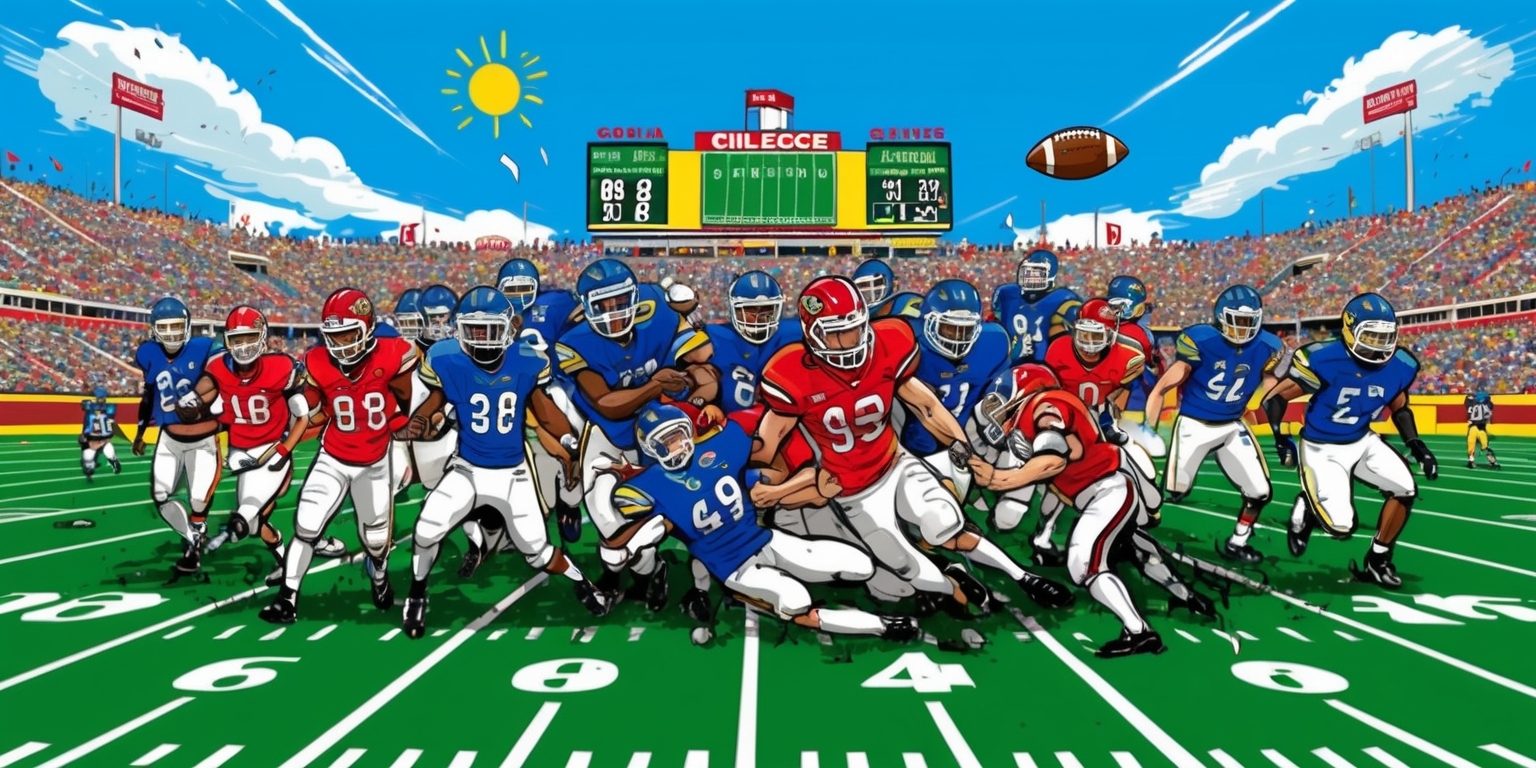Defensive Strategies Unleashed: Mastering Formations and Tactics in College Football 26
Aug-18-2025

College Football 26 invites players to delve into a world where strategic defense is as crucial as an explosive offense. The game provides an arena for tactical mastery, where every formation can Act as the pivotal element that delineates triumph from loss. Players are encouraged to explore defensive playbooks that combine traditional setups with innovative adjustments, offering an experience that challenges both quick thinking and strategic planning. With the freedom to choose custom or preset formations, enthusiasts can experiment with different approaches, tailoring their tactics to counter specific offensive threats. This rich tactical landscape not only rewards careful planning but also demands adaptability in real time, proving that a well-crafted defense often lays Laying the foundation for triumph on the digital gridiron.
Dynamic Defensive Tactics
Within College Football 26, the emphasis on defensive maneuvers is critical to outsmarting an opponent’s offensive strategies. The game empowers "allowing players to explore an extensive variety of" defensive schemes, each tailored to counter various offensive plays. This dynamic Field necessitates an in-depth grasp of how to adjust and use different sets, ensuring that each formation is not only robust against an advancing offense but also versatile enough to cover sudden transitions. Enthusiasts can employ strategies that support both aggressive pass disruption and solid run-stopping plays. The interplay between rapid decision-making and strategic foresight makes defensive planning a central element. By mastering these defensive tactics, players find themselves better equipped to adapt throughout a game, consistently countering the diverse challenges presented on the field.
Customization and Playbook Versatility
One of the appealing features of College Football 26 is the option to select any team’s playbook, giving users the freedom to create a unique defensive identity. This flexibility allows players to blend various play formations into a custom playbook, enhancing their ability to respond to offensive shifts. Whether opting for a well-balanced scheme or a formation that is designed for a particular style of play, the customization aspects offer creative control. Each playbook not only dictates the on-field positioning of players but also influences the pace and timing of defensive responses. The option to tailor your defensive strategy fosters an environment of ingenuity, where experimenting with different formations may reveal unexpected synergies and tactical advantages on the virtual gridiron.
Mastering the Details of Formation Selection
Seasoned players understand that selecting the right formation is an art form in itself. College Football 26 emphasizes that no single playbook is a silver bullet; the success of a defense is measured by its ability to adapt on a play-by-play basis. Players must sift through the nuances of each defensive strategy and consider factors such as player strength, opponent tendencies, and clock management. This detailed selection process encourages a deeper engagement with the game’s mechanics. It demands attention to detail, as even slight miscalculations in formation timing or assignments can lead to an exploitable gap. The mastery of these finessed details helps create a resilient defensive framework, turning tactical theory into on-field effectiveness through precision and experience.
The 3-4 Defensive Formation in Depth

The 3-4 defense stands out as a timeless formation within the game, blending a sturdy interior presence with dynamic linebacker versatility. In this structure, three linemen anchor the center of the defense, providing a bulwark against the run while allowing four linebackers to roam and adjust based on offensive motions. This balanced formation requires in-depth understanding of player positioning and responsibilities. Key roles center on reactive pass coverage and proactive gap control. The flexibility of the 3-4 brushstroke makes it effective against both short-yardage gains and deeper passing attempts. In the context of College Football 26, performing well with this playbook means often outsmarting offensive schemes through quick shifts and precise assignment reads, ultimately thwarting complex offensive blueprints with coordinated defensive discipline.
Exploring the 3-3-5 Formation
Venturing into alternative defensive strategies, the 3-3-5 formation offers a unique blend of speed and coverage. With a setup featuring three defensive linemen, three linebackers, and a formidable quintet of defensive backs, this formation is particularly adept at confusing passing lanes. Its design emphasizes flexibility, often relying on quick shifts in player responsibilities to offset the reduced presence of traditional pass rushers. As such, players are encouraged to lean on well-timed pressure from the secondary and precision in pre-snap adjustments. This formation requires constant vigilance and an acute sense of timing, as defensive backs must accurately judge routes and react accordingly. The balance between aggression and zone discipline makes the 3-3-5 a potent tool when executed with flawless coordination, challenging opponents to find a reliable target in a tightly knit defensive web.
The 3-2-6 Configuration: A Pass Vanguard
For players who prefer a strategy that prioritizes defensive coverage over aggressive pass pressure, the 3-2-6 formation stands as a compelling option. This structure heavily features six defensive backs, supported by a smaller contingent of traditional linebackers and linemen. The primary objective here is to neutralize passing plays by saturating the field with quick, agile defenders. By heavily investing in speed and coverage, the formation creates a formidable barrier against opponents who rely on precision passing routes. However, Consider this alternative: "the trade-off essentially hinges on the challenge of" generating consistent pressure on the quarterback. Success in this configuration depends on the ability to predict quarterback tendencies and to coordinate rapid shifts across the defensive line. When executed properly, the 3-2-6 formation becomes a strategic fortress, upending the offensive rhythm and forcing hurried decision-making under pressure.
Analyzing the 4-2-5 Formation Strengths
Bridging the gap between run defense and pass coverage, the 4-2-5 formation presents a balanced approach to modern college football defense. This formation integrates four defensive linemen, two linebackers, and five defensive backs into its scheme. Its design is tailored to accommodate both ably defending against the run while simultaneously pressuring the quarterback. In this setup, one of the defensive backs often assumes a role that merges coverage with pass pursuit, lending versatility to the unit. The 4-2-5 formation's adaptability makes it robust in the face of varied offensive tactics, allowing for quick shifts in emphasis based on the opponent’s strategy. Players who choose this playbook enjoy the advantage of a layered defense that can contract quickly to stifle both ground-based aggression and aerial threats, capitalizing on well-coordinated positional play.
Balancing Tactical Depth and Adaptability
College Football 26 demands that players not only choose the right formation, but also maintain the ability to adapt quickly within a game. This balancing act between tactical depth and situational flexibility is what elevates the defensive unit from merely competent to truly formidable. The game’s interface allows for pre-game adjustments as well as on-the-fly tweaks during critical plays. Successful managers often employ a combination of hard-hitting formations and fluid adjustments based on the offensive setup. This ability to blend predetermined tactics with real-time decision-making means that no single formation can provide a guaranteed answer. Instead, tactically astute players build their confidence on a foundation of diverse defensive strategies, prepared to pivot at a moment’s notice when the opposing team shifts its momentum to exploit vulnerabilities.
Game-Changing Elements in Defensive Playbooks
The strategic merits of any defensive playbook in College Football 26 lie in its potential to turn the tide during pivotal moments of gameplay. The art of anticipating an opponent's offensive maneuvers, combined with the versatility of custom playbook adjustments, creates opportunities for game-changing shifts. Whether it is a sudden change in alignment or a pre-snap read that adjusts the entire formation, the exultation of a well-executed defense resonates throughout the virtual stadium. The range of formations—from the stalwart 3-4 to the agile 3-2-6—illustrates the possibility of exploiting a momentary advantage. Players who refine their understanding of these elements often find themselves turning defensive stands into offensive counterattacks. This dynamic intensity reinforces how essential adaptive strategy can be, making every defensive play a potential catalyst for momentum shifts.
Executing Strategic Adjustments On the Fly
One of the most engaging aspects of College Football 26 is the ability to modify formations during key moments of gameplay. In an environment where every second counts, the skill of making effective, real-time adjustments can transform a defensive strategy into an offensive counter-move. This requires an in-depth grasp of the intrinsic merits and weaknesses of each formation, as well as an anticipation of the offensive methods being employed. Players who are proficient in quickly reading the opponent’s setup can reassign responsibilities, alter coverage schemes, and even switch to entirely different playbooks mid-drive. The capacity to execute these strategic adjustments under pressure is a testament to a player’s tactical acumen and familiarity with the game’s mechanics. These in-game decisions are not merely reactive; they are crucial components of a proactive, dynamic strategy that often defines the outcome of a game.







